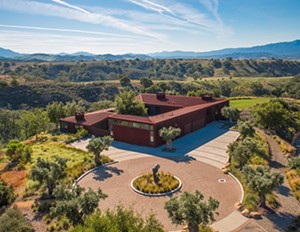At Allan Hancock College on a Friday afternoon, a 24-year-old woman named Elizabeth Pampa finished cleaning and arranging tables and chairs into a neat pattern. She and her coworker were preparing the conference room for its next meeting.
Between this job and another one at a church in Orcutt, Pampa earns about $800 per month and pays roughly $400 to rent a house on the north side of Santa Maria.

She only has around $100 in discretionary income after expenses, although her fiancé (an undocumented worker who’s also studying at Hancock) is able to help with some cash income he earns from mechanic jobs he takes on the side. Someday she hopes to make a living as a professional photographer and afford to buy a house, but she got discouraged when the bank raised her mother’s mortgage by $400 in the past year alone.
“Everything is just going up and up and up,” Pampa told the Sun.
A bunch of important people—a who’s who of established local politicians and would-be politicians, businessmen, city and nonprofit administrators, and school presidents, all dressed in fresh-pressed business attire—gathered at a forum held at the Riverview Community Center in Guadalupe on Jan. 14 to discuss what many people in North County, like Pampa, have known for a long time: that it’s an expensive place to live and something should be done about it.
The professionals discussed myriad possible solutions set forth by a collaboration between the United Way and EconAlliance called WALI, or Workforce and Literacy Initiative, that outlines basic goals they hope to achieve in North County by 2020, with a heavy emphasis on improving basic education levels of residents.
All of this comes on the heels of a newly released United Way report titled Struggling to Get By: The Real Cost Measure (RCM) that paints a bleak picture for nearly a third of county households who aren’t earning the amount of income needed to meet basic needs. The number is even higher—94 percent—for families with only one working adult.
According to the report, a family of four—two adults and two kids—needs $56,279 to pay for the most basic needs such as food, housing, health care, transportation, child care,
taxes/credits, and miscellaneous costs.
The report illustrates the vast difference between the worlds of south and north counties, where on one hand you have billionaire celebrities like Oprah Winfrey in Montecito and on the other residents like Pampa in Santa Maria.
The RCM figure exceeds the U.S. Census data for median household income for both Lompoc and Santa Maria, which are $45,818 and $50,563 from 2009-13, respectively.
But census data alone doesn’t paint an accurate picture: 2013 figures show that unincorporated Orcutt has a median household income of $69,179; $77,750 for Vandenberg Village; $66,076 for Buellton; $63,626 for Solvang; $64,434 for Santa Barbara; and $125,560 for unincorporated Montecito, where the celebrities live.
The median for Santa Barbara County overall is $62,779. However, United Way of Northern Santa Barbara County CEO and President Eddie Taylor said the new report is more realistic because it takes into account several measures other than census data, including the Human Development Index and The Elder Index, and the Federal Poverty Level, a measure that Taylor said hasn’t been updated since the 1980s.
A living wage calculator from the Massachusetts Institute of Technology finds that the sole working adult in a family of four in Santa Barbara County would need to make at least $25.83 an hour to make ends meet, and that still doesn’t meet the RCM in the report.
“You have no discretionary income,” said Taylor, who added that some things like cell phones and the Internet are necessities now but weren’t considered 30 years ago. “A lot of things have changed. The basic cost of living is going up, and wages aren’t keeping pace.”
Taylor added that the number of households below RCM could be higher in North County.
Why does it cost so much to live out here? It’s a bit tricky to measure, but Cal Poly economist Steve Hamilton said the cost of living in California generally rises through real estate prices.
In this case, Hamilton said it’s important to think of real estate as an investment. Houses in the county are “screaming good” investments these days, Hamilton said, and owners who bought houses in the 1990s are seeing their values double. This is in part because of the attraction to wealthy outsiders, who want to live near the scenic beauty: the oceans, mountains, and wineries, etc. The median price for homes in Santa Barbara County is $547,100, according to Zillow.
Housing takes the lion’s share of the RCM. While homes may be out of reach for lower income folks, Hamilton noted that the situation is different for rentals because their prices are typically determined by the cost of building materials.
“If you’re renting, it’s not that much more expensive,” Hamilton told the Sun. “What’s real impossible for people is home ownership, which is a problem because you want people to own houses where they live and work. But then they’d have to have a decent job to afford a house.”
Transportation costs are expensive too. Public transportation is widely available, yet costs for owning a car are generally high. And gasoline is more expensive in California for several reasons, namely because of a lack of connection to any major oil pipelines, growing demand for oil, stagnating refinery capacity, and the use of environmentally friendly blends.
It’s not particularly good news for a region still recovering from the recession and whose unemployment rates crept up recently. The Santa Barbara County unemployment rate went up from 5.1 to 5.5 percent from November to December 2015 (still below 2014 figures), according to the California Employment Development Department.
How will WALI goals be achieved? Santa Barbara County 3rd District Supervisor Doreen Farr gives some insight. With 68 percent of residents not having a high school diploma falling below the RCM, Farr said there’s no coincidence between low wages and having less than a high school education.
“Education level is of primary importance,” Farr told the Sun.
When it comes to improving education as a whole, Farr emphasized that giving more resources to public libraries goes hand in hand with WALI’s education objectives, such as expanding English language programs for immigrants.
Hamilton contends that it’s not simply better education that offers the best chances for success, but also entrepreneurial skill and a willingness to take bigger risks.
That may be hard to do for Pampa, who finds policies to help the poor a little out of touch with her situation. She can barely scrape together enough money for her camera equipment and is always finding new ways to get by. She’ll be looking for jobs soon.
“I kind of have to find loopholes to survive,” Pampa said, adding that she does have some hope for the future. “I’m voting for Bernie Sanders. I think he genuinely cares about people who are not rich.”
Staff Writer David Minsky can be reached at [email protected].










